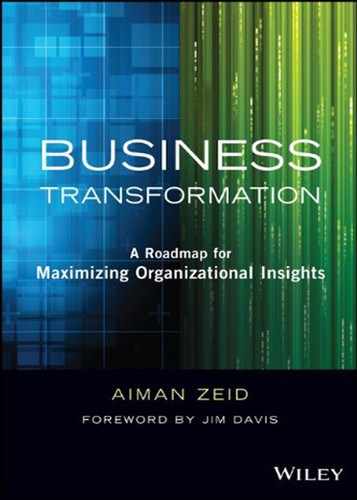Preface
Over the past 28 years of my professional career, I had the opportunity and privilege to work with many clients in almost all industries and sectors in the United States, Europe, the Middle East, Asia, and Latin America. I have helped these clients improve their efficiency, change their operating models, and transform their organizations. Although each region has business and cultural differences, all organizations face the same types of core challenges when they look closely at their operating models and evaluate their efficiency and alignment. When organizations realize they have a weakness in their decision-making process, strategy, or business functions, the first impulse is go with the easy answer first. Often in my travels I've seen a new technology being touted as a cure-all. And while new technology might be needed, the business results could vary considerably. Visionary leaders and executives realize that the key to unlocking their organization's full potential requires honest and objective observation and evaluation of how the organization conducts its daily routine tasks.
Two key obvious ingredients are required to develop strategy and make sound decisions—information and skills. Accurate and consistent information provides a detailed understanding of business performance. People with the right skills can explore this information and analyze it to help their organization make sound decisions. This may be all organizations need if they limit their view to specific tasks or functions. But the focus should always be on enterprise performance. The formula for an efficient operating model will now need two more ingredients. Decision makers from various business units need to interact and collaborate to make the right decisions for the enterprise. Then the human nature characteristics and challenges quickly bring our attention to the internal organization culture that we all recognize in our individual environments. Each environment has its own unique formal and informal business practices, norms, and expectations that influence how decisions are made.
Aligning all business units around enterprise performance can be difficult. Effective organizational transformations can achieve alignment when organizations focus on their four key pillars—people, processes, technical infrastructure, and culture. The winning organizational transformation formula is now complete. When I visit clients I emphasize that it doesn't matter that you've mastered one, or even two, of these factors—you need to work on all of them to bring your organization into alignment and truly transform it. Think of it like a recipe. Cut out a key ingredient, or substitute a poor alternative, and the recipe won't taste the same—it might not even work. It's the same with organizational transformation. If you ignore the culture part, the best technical infrastructure in the world won't help you improve the organization's business performance.
Many visionary leaders and executives realize the need to take a comprehensive look at their organizations. Addressing weaknesses and leveraging strengths in the current capabilities in each environment requires business transformation efforts in many cases. Leaders who realize that and, more important, act quickly can produce significant results for their organizations. I wrote this book because many executives still struggle with how and where to start. Approaching these complex organizational challenges needs a structured approach and a sound strategy that is tailored for each environment. This has been a significant focus of my professional career, and I wanted to share my experience and provide a roadmap for organizations to follow.
